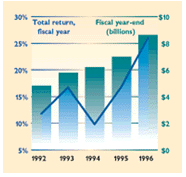
Main Menu ·
Search · Current Issue · Contact · Archives · Centennial · Letters to the Editor · FAQs


|
Chart by Stephen Anderson
|

Harvard's endowment grew $1.6 billion during the past fiscal year,
and exceeded $8.6 billion on June 30. The University's financial statements
will not be released until early December, but back-of-the-envelope calculations
suggest that-after accounting for endowment funds used to support University
operations (an estimated $330 million) and new capital gifts received-investment
returns for the year easily exceeded $1.5 billion. Unsurprisingly, in his
annual letter on endowment performance, written in mid-September, Jack R.
Meyer, M.B.A. '69, president of Harvard Management Company (HMC), characterized
the results as "exceptional."
And so they were. During a year of strong financial markets, total
return-income and realized and unrealized gains on investments-was 26 percent
after all expenses. While HMC has recorded bigger one-year gains-31.3 percent
in the robust 1986, for example-Meyer said in an interview that this year's
results represent "the largest margin of outperformance" relative
to peer funds. The median investment return for large funds measured by
Trust Universe Comparison Service was 17.6 percent for the year.
In most categories of assets, HMC beat its market benchmarks. In managing
the large domestic equity portfolios, Meyer noted, "Everybody did pretty
well." The stock-selection strategy exceeded its benchmark by almost
9 percent, "two to three times" what Meyer said he thought possible.
The arbitrage strategy, driven by portfolio manager Jonathon S. Jacobson,
M.B.A. '87 (see "Six-Million-Dollar-Man," September-October, page
75), exceeded its market benchmark by more than 14 percent. The aggregate
return on domestic equity investments for the year was 34.5 percent.
Three other asset classes merit comment. The small pool of commodities
investments, which had a negative return in fiscal 1995, gained over
46 percent this year as the futures markets magnified the effect of rising
oil and natural gas prices. Private equities, 15 percent of investments,
returned almost 44 percent-but still managed to trail the benchmark appreciation
for the year. Meyer explained that HMC private equities that are managed
externally-about half the total-benefited from the "hot IPO [initial
public offering] market for high-tech stocks," whereas internally managed
funds are invested in different sectors. The only other class of investments
to trail the market was the small pool of high-yield bonds, accounting for
about 2 percent of assets.
Meyer was at pains to end his letter on a "cautionary note,"
warning, "Clearly there will be years ahead when absolute performance
is negative and years when we underperform."
But in the meantime, he took an evident note of personal pleasure in the
most recent results. "It was a great year," he said during the
interview. "What pleases us even more is that we now have a five-year
record." Since HMC was reorganized and began pursuing its current strategies
(effective July 1, 1991), its annualized total returns have been 16.1 percent-2.4
percentage points better than the benchmarks for its model portfolio, and
3.3 points ahead of the median institutional fund.
For those concerned about bragging rights, that performance ranks Harvard
"easily in the top 5 percent" of competitors, Meyer said. More
important, the superior performance relative to median funds translates
into $1.4 billion of additional endowment growth. At the current "distribution
rate" of 4.5 percent to 5 percent of the endowment's market value,
he noted, that generates more than $60 million in extra operating funds
for Harvard each year.
Main Menu ·
Search · Current Issue · Contact · Archives · Centennial · Letters to the Editor · FAQs

![]()
![]()

![]()